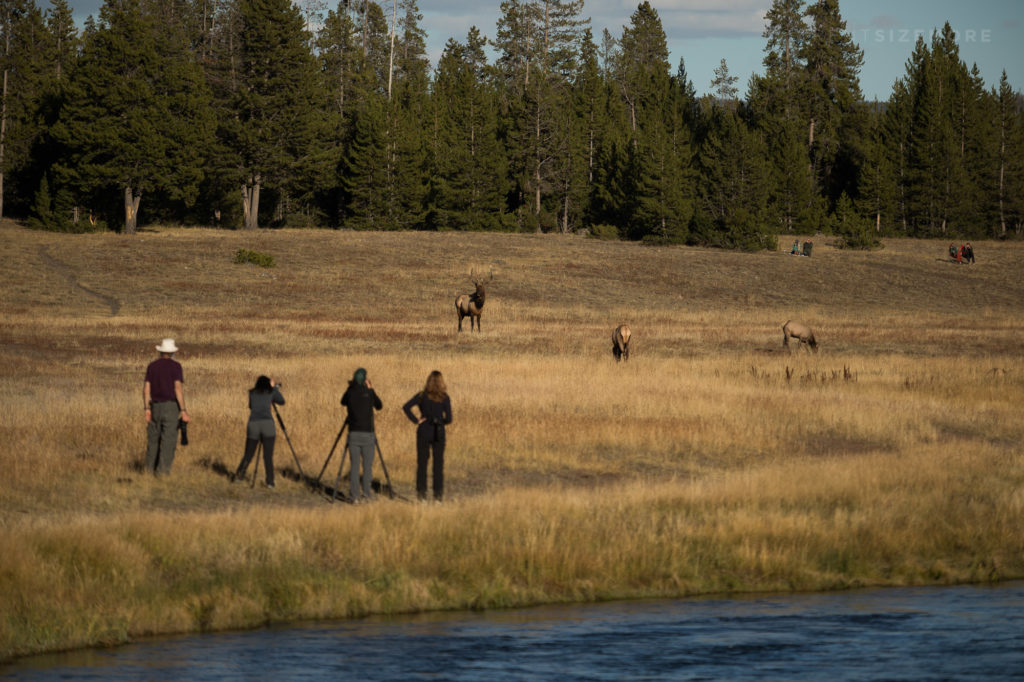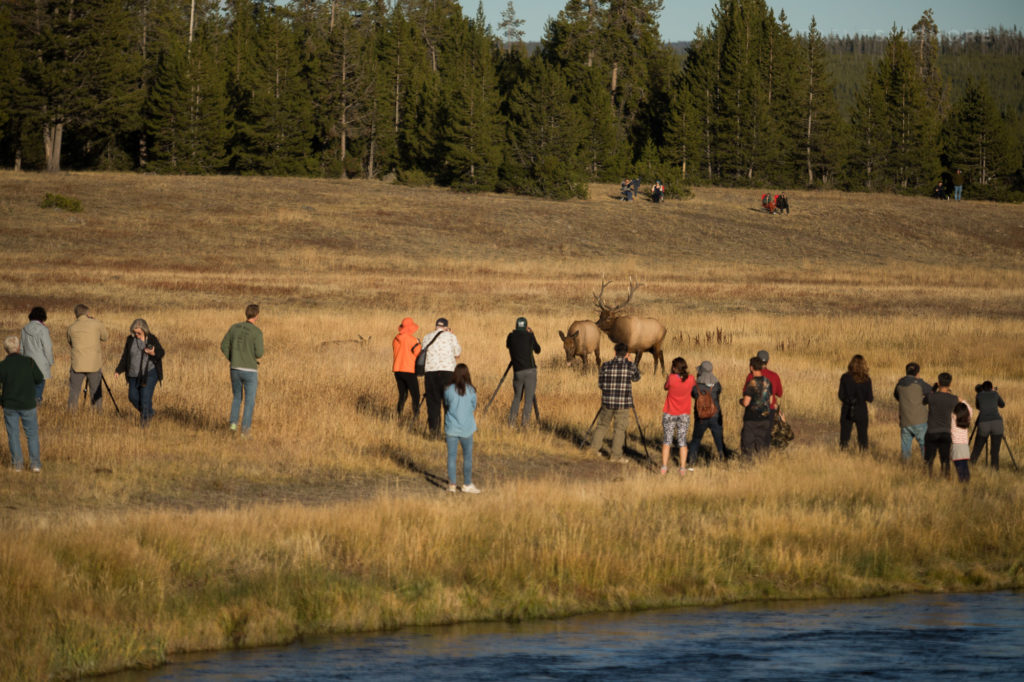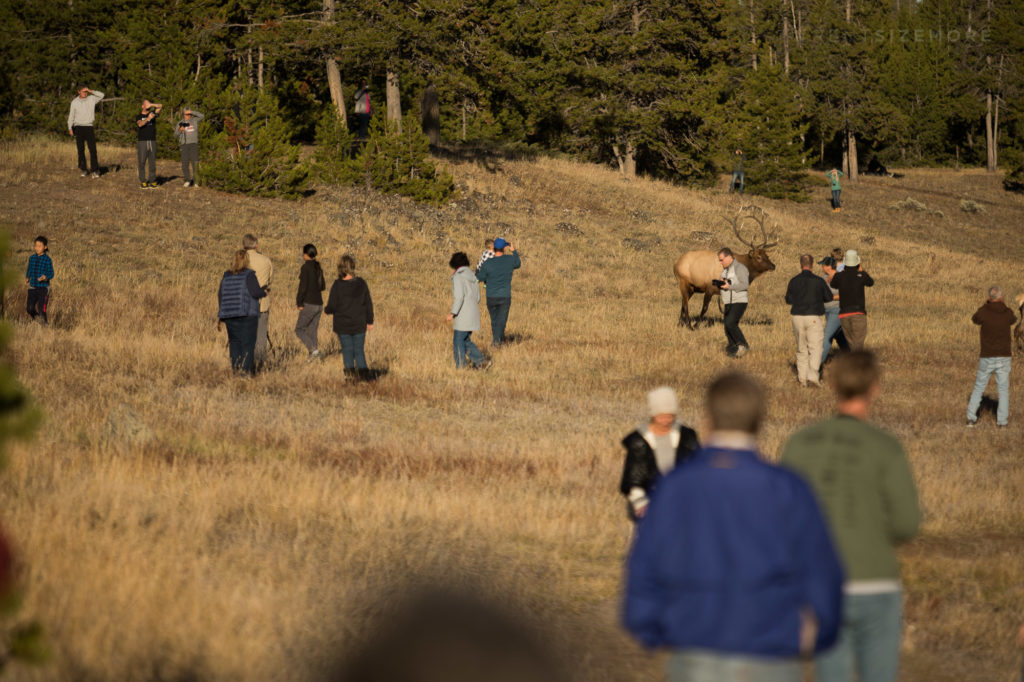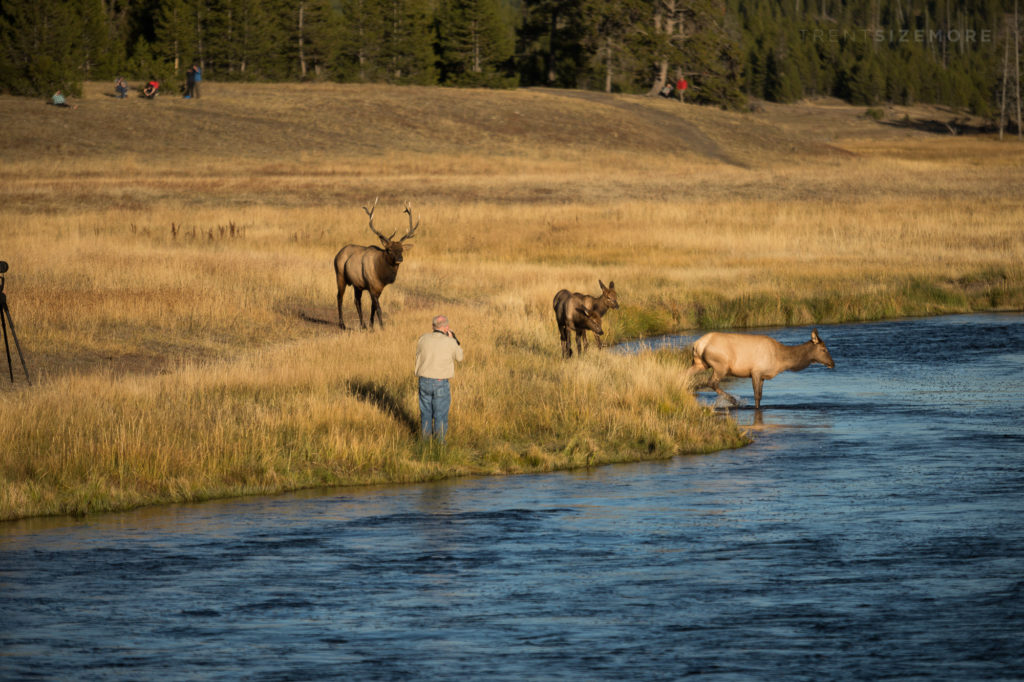Wildlife photography in Yellowstone National Park is an incredible opportunity, yet some bad photographers are giving all photographers a bad name by not following the rules. I won’t even get into the plain rudeness of too many “professionals” that further that bad name.
The rules for wildlife viewing in Yellowstone are very simple. You’re required to stay 100 yards away from bears and wolves, and 25 yards away from everything else. If an animal approaches within that distance, you’re supposed to back up or leave. If an animal is outside that distance and changes its behavior because of you, you’re still too close. The ONLY exceptions are when a park ranger is on scene and allows the group to approach closer, or you’re driving by animals in your car.
Too many “photographers” visiting Yellowstone just don’t seem to get it, many of those calling themselves professionals. Even worse, more than a few obviously desperate photographers go as far as purposely harassing wildlife for a photo op.
Although I’m sure many disagree, I see nature photography as photographing nature completely undisturbed. Anything that causes an animal to change its natural behavior is pushing the lines of harassment. Accidentally disturbing an animal is just that – an accident, as long as you remove yourself from the incident. Purposely whistling at, clapping at, chasing or baiting an animal to get your selfish shot is unquestionably unprofessional. You don’t need an animal to look into your camera. You don’t need to be close enough for a full frame head shot with your 300mm lens.

One day this fall, I watched what started as a few people photographing the bull elk on the Madison River quickly escalate into a dangerous scene because of the “monkey-see-monkey-do” syndrome. The four people above appear to be photographing legally, but even the legal 25 yard distance is not safe when a testosterone-filled bull elk is running around.

When a bull elk is bugling directly at you, it’s time to move. Take notice of the man carrying a young child to get his cell phone photo below. A few photographers made it seem okay for everyone else to get as close as they wanted to a dangerous animal.

Even when the bull became very aggressive towards the crowd and was hurrying to gather his cows, a couple of mindless photographers still remained. If a park ranger was there (I never saw one), he/she would have had a fit.

I’ve driven over 12,000 miles through Yellowstone this year alone, so I’ve seen just about everything short of an actual animal attack. I’ve watched photographers with large lenses chase elk, coyote, fox, bison, and even bears. I’ve seen people with cell phones attempting to get the same photo as the professionals, requiring them to get even closer.
If you see a photographer harassing wildlife, you can try to speak up and get them to leave. If you’re lucky, they’ll know they’ve been caught and move on. If you’re not (usually the case), you’ll get an earful and nothing good will happen. It’s hardly worth trying to intervene, unless they’re disturbing animals you were already photographing.
Very seldom is a park ranger going to be in right place at the right time to be able to see someone violating the wildlife laws. If you feel so inclined, you can film the illegal activity, making sure to get undeniable proof including their license plate. Turn it into a ranger or visitor center, and the NPS will take the appropriate action.
If you’re so desperate to “get the shot” that you have to chase an animal around, please do all photographers a favor and stay home.


Interesting article Trent. I’m a leader of nature tours with over 20 years experience now. I lead regularly in Japan. A somewhat recent problem is people (including photographers) throwing tidbits to foxes and other animals to entice them out onto the roads. Of course, this becomes a habit and next thing you know, you have a flat fox or raccoon dog. Earlier this year I encountered a group of Europeans on a photo workshop and suggested they stop throwing a stone close to a fox to get it to come out. The reply was “it’s not food, so it’s okay”. They knew perfectly well the fox thought it was food, and I pointed this out, they then proceeded to tell me f**k off (their words). If you don’t care about the welfare of the animals, you have absolutely NO business photographing them….
A college group from Montana Tech in Butte Montana collared and studied Big Horn sheep near Georgetown Lake. The conclusion of the study had some interesting points the most relevant being that when they were around people, though they just stood and grazed, they were freaking out on the inside. Just because they do not show signs of aggression or agitation they are stressed and a situation could escalate quickly.
Years ago, when visiting Glacier National Park, there was a group of mountain goats amazingly close to the road and a parking area. The group included some young and one very vigilant adult. A crowd of tourists ensued and the sheep seemed ok with us close. That was, until a guy gets out of a car with a very agitated and aggressive German Sheppard! The vigilant adult went right at the barking dog and the bozo holding it’s lead. 27 years later I can still see the mayhem in my head. Once I saw the speed and power of the charging goat, I realized my then-pregnant wife and I had made a poor choice joining the crowd only feet away from the animals. Thanks for the great blog.
Trent, you are 100% right. Harassing wildlife is unethical and in some states, illegal. Equally bad, when idiots get hurt, the animal (who acted naturally) is killed. Watch this: https://www.youtube.com/watch?v=UK-RN8C1mOE
“You don’t need to be close enough for a full frame head shot with your 300mm lens.”
that was rude and low. so you have a 500mm/600mm lenses and you think you’re better than others because of that? haha.. im all for NOT disturbing wildlife. i will never chase deer in order to get my shot. because i dont want them to get out of their territory into a highway. but i dont agree with your condescending.
You aren’t entitled to break the rules and get closer just because you don’t have the correct equipment for the shot you want. Considering you can get a lens with 600mm for under $1000 there’s no excuse.
How is that condescending? It’s a FACT – if you don’t have the right equipment then you have NO BUSINESS trying to make what equipment you have work when you know it won’t, and that’s not just with photography, it’s in ANYTHING you want to do.
You don’t go tent camping in the Rockies in January with equipment you bought at the local five-and-dime, you don’t go buy a car off the showroom floor and enter the Daytona 500, photography is no different.
It is funny watching the hazard-courting photogs drifting closer and closer to the wildlife equipped with pointy things! You feel as if you should say aloud: “Wait for it…” 🙂
This is what passes for wildlife photography now? Photographing habituated or, for practical purposes, “tame” animals? About as challenging as photographing cattle. I guess I had an idealized notion of wildlife photographers. I imagined them trying to get close enough to WILD animals – stalking – spending hours in blinds – that sort of thing. Didn’t realize the big lenses are so they can stay in the car and avoid getting tourists in their shots.
If you want to be a master carpenter, you’re still going to start with a simple birdhouse. Fortunately the greater Yellowstone ecosystem has 20 million+ acres with plenty of WILD animals for those that desire a bigger challenge.
We saw an example of this at Bushkill Falls in Pennsylvania. Approaching a crowd gathered along the trail, we saw a bear cub about 50 yards away. The cub ambled along and disappeared behind an outcrop. One man (with camera) began walking up the hill towards the outcrop, while his wife yelled at him in a language I do not know. Probably something like “Get back here you damned fool!” We left, not wanting to see the result of such foolishness.
I wish we could post pictures, because I have a television film crew scaring a herd of big horned sheep on to the road and traffic in Banff. It’s not just tourist who offend.
Many professionals act worse than amateurs or tourists. All professionals know the rules, but a few choose to ignore them.
It always surprises me how unethical wildlife photographers are. Have some respect for the great animals you are shooting.
Great advice from many knowledgeable people in here. I am afraid to say stupidity does not just take place in Yellowstone but is international in that it is prevalent the world over. Personally I do not care a great deal if someone intrudes on a wild animal and gets justice for that, it is a form of Darwinism.
What I am concerned about is if such an action affects the wild animals?
The animals eventually get habituated to human presence, allowing people to get closer and closer until it’s TOO close and the animal has to defend itself.
This is the same in all world. Maybe in the future some distance rules should be added to protect the fauna from observers and photographers. Something like an animal should be observed on a distance bigger then 100x or their approximate body length.
There are already rules for distance in National Parks, but they cannot be enforced.
Here’s an easy way to tell if you’re too close, and this is what the Park Rangers will tell you: Hold your thumb up at arm’s length. If your thumb doesn’t completely cover the animal, then your too close. If you want a closer view of the animal, buy/rent a longer lens. The NPS is horribly underfunded and there are too few rangers to patrol a large park like Yellowstone, so it’s up to visitors to exercise some common sense. Of course, far too many don’t have common sense. So, if you want to get a selfie with a Buffalo, and you end up gored, you’ve just proven Darwin’s principal. The thrill of a park like Yellowstone is to be able to observe wild animals in their natural habitat. Their “natural habitat” does not include humans invading their space and altering their behavior. So, please remember the “thumb rule”.
In 1980 I saw tourists walking within 20 ft. of full grown bison at Yellowstone.
Less than a month a French tourist was gored and trampled to death by a bison at Yellowstone. People are idiots when it comes to this stuff. Too many Disney movies have humanized wild animals.
There the rules of the parks, you have to follow them. That make sense.
Now the term isn’t being professionnal, as I don’t understand what it does mean there. The term is being respectful of the rules and being aware of the risks you may take.
The interresting things is the rules are different in each country/park. Been to Tanzania and there no minimum distance but you have to stay in the car at all time. In many areas you have to stay on the roads. And you get outstanding pictures with a simple 70-300 then.
For whales, in France my country or Canada/US you can’t go near. Forbidden by the rules. In Iceland they don’t care. Their boat have sonar to check where the whales are in the sea and the boat follow them so they always know where the whale actually is; When the whale go out to get some air, it is a few yard away, you can take the photo with a wide angle.
In all cases I think a professional photographer/videographer will put himself in the conditions to get the shot. Many time it will be setup because that get you better results. Exactly like many well known so called “street photography” shots where actually setup. Because that what give you the best results.
Like it or not, being a pro isn’t about being the most respectful of wildlife or whatever, but about getting the job done and being paid for it.
Slowly but surely, more professionals are being held to higher standards of ethics. For example, remote camera traps are supposedly no longer allowed in Yellowstone. There’s nothing wrong with a remote camera in theory, but if it disturbs an animal then it is wrong. The wide angle bear and wolf shots in the recent Nat Geo magazine issue on Yellowstone surely gives the impression that anybody should be able to get that close to one. Professional publications like Nat Geo are getting special access to areas and more leniency on rules that the rest of us still have to follow. I suspect that will eventually end.
Maybe that will change but see… This means that the pro don’t follow the rules. They get to bypass the rules that apply to others.
The rules are for amateurs and actually half of being a pro is being able to get access. This is the same in other practices. Half of the fashion shot looking so great is working with model that manages to look great even if you ask them to wear a sack of potatoes. Half of the sport shot looking so great is being allowed pro gear and great spots.
Actually the basic tourist going too near the wildlife is as usefull as the respectful. They pay the same taxes and entry fee as others and without their collective money the park may not have been possible.
Maybe the selffie near the wildlife is a bit supid, but they paid for it and that their money as much as your that keep the place a reserve without much human activity.
Is it really “useful” for tourists who pay taxes to destroy the park for everyone else? If “the shot” involves walking across a spring and destroying the bacterial mats four everyone else, or spray painting/leaving burn marks on rocks (or knocking them down because someone jumped off them and it went badly), or if it involves disturbing wildlife in one of the few places left for it to live naturally, especially if there’s a chance of people getting injured and blaming the park… that may be in the interests of one tourist, not in the interests of all of them.
Many, I hope most, of the visitors will want to see the parks as pristine as possible, with wildlife living wild. Selfish activities of a few “paying” don’t justify their spoiling things for everyone else who’s also paying. (I’m British, but I do have an America the Beautiful pass and I’m a Yellowstone association member).
My desire to stop people acting selfishly in a National Park will modulate their enjoyment once, but allow them to enjoy them longer and in other ways. If we let people ignore the rules, Yellowstone will have to turn into a zoo, with dead geysers behind netting. I’ve been to San Diego Zoo Safari Park – it’s cool enough, but definitely not the same. And even zoos have idiots trying to climb in with the animals.
Everyone I’ve met in Yellowstone gets along and appreciates the environment they’re in – we need to welcome people to that ephemeral community and teach how to enjoy what’s there sustainably and unselfishly – allowing a chance to learn and teaching rather than ostracising people who make mistakes.
But that doesn’t mean giving them carte blanche to keep acting in that way. There’s enough entitled and selfish behaviour on notalwaysright.com – when it spills over into what is supposed to be a communal experience, it really shouldn’t be acceptable.
Regardless of one’s photographic status, there is a moral aspect to the equation that should be followed. There is no sound justification to ignore what is morally correct. Have we all forgotten what we were taught by our parents and grand parents? Ignorance isn’t an excuse and it sometimes demands payment i.e. in injury or death to those claim it. As humans we need to stay above such disrespectful actions and conduct ourselves appropriately.
All of us locals really appreciate the entertainment of idiots who insist on demonstrating the Darwin principal. As far as speaking up and getting an earful from some liberal photographer, relax Cupcake. When you legally open carry, no New Yorker is going to give you any lip.
Um, how do you know you are getting an earful from a ‘liberal’ or ‘conservative’ photographer? Are they carrying a sign? I’ve met boorish people of all political affiliation/race/culture in my life.
Sadly, such behavior is only becoming normal all over the world. Couple of days ago, some Chinese tourists were caught chasing endangered Tibetan antelopes with off road vehicles to get ‘the shot’. Then there are idiots who will move bird nests/eggs for photos. And it’s not limited to wildlife photos either. Go to any famous vista point in any National Park and you will find that a-hole who plonks his tripod in front of everyone else to get that shot.
And if they should get injured or worse killed, you’ll hear about them wanting to sue the National Park Service, because of their stupidity…
ABSOLUTELY RIGHT. PHOTO THE ANIMALS IN THEIR NATURAL HABITAT AND STAY BACK AND AWAY SO OTHER PHOTOGRAPHERS DONT HAVE TO SETTLE FOR A PHOTO WITH STUPID PEOPLE IN THE PICTURE!
An excellent and all to often needed article. I had a somewhat different experience though. I was in Yosemite NP, hiding in the woods about 300 yards from a small group of Bison and getting some great shots (film back then), and heard a ‘huffing’ at my back. Turned around to see a big bull elk nosing around my camera bag. He also came up and nosed my pockets presumably looking for food. He ambled off when none came.
He was clearly at home with people, quite “friendly” and my moving off would probably have upset him so I just stayed-put
A great event for me, (less so for him) but he did get elk slobber all over some expensive pieces of glass!
Having commented on dpreview, I need to confess my guilt here. I’ve just got back from Yellowstone, and found in the EXIF that I was actually only 60 yards from a bear I thought I’d stopped 100 yards from. Fortunately the bear didn’t appear disturbed, and I was by a car door and definitely safe, but I feel bad and will adjust my estimation of distance in the future.
I’ll say that, if you’re not used to it, 100 yards is quite a hard distance to eyeball. I doubt I’m the only well-meaning person who thought they were following the rules who got too close. It’s not an excuse – I’m entirely at fault – but I can see how it happens, and repeating “stay 100 yards away” isn’t, sadly, enough to help. (I’m going to try to get my eye in somewhere measured before I go back.)
On the other hand, people walking right up to, and disturbing, wildlife are idiots and need yelling at. Which I did, to some people trying to take selfies with elk and trying to approach a bear. The more ways we have of telling those people to back off (before they visit), the better.
If you’re standing at your car door and think you’re far enough away (nobody can measure 100 yards on the spot), I’m sure you’re fine. Your situation is much different than someone who knows they’re too close.
I’m reasonably sure no harm was done in my case, except to my conscience. But as the article points out, if you think you’re okay, someone will use your estimate to guide their own actions, and then someone else will position themselves based on that, and eventually someone gets close enough that new arrivals don’t realise they should be hanging back at all.
It’s on all of us to police each other. Fortunately everyone I met in Yellowstone was friendly and helpful, and fairly active about (fairly politely) telling people not to break the rules – behaviour which I did my best to emulate. When a coach load empties out and all breaks the rules at the same time, especially with a language barrier, I can see it’s harder to guide people.
I don’t know a solution, but more publicity on the problem surely helps. I just hope we can all stay civil about genuine errors, however frustrating that are to see.
And, of course, there’s a difference between:
1) Those who know the rules but accidentally break them (and need telling they’re doing so).
2) Those who don’t know the rules and need telling what the rules are.
3) Those who know the rules but forget in their excitement, or assume everyone else knows the right behaviour and go along with the crowd.
4) Those who know the rules and selfishly and deliberately break them anyway.
I hope peer pressure can control as many of these as possible and keep parks like Yellowstone a pleasure to visit (even for those of us not able to trek to quieter off-road parts).
While selfies make it worse, I’m not sure this is entirely a photographic phenomenon, by the way. I’m sure people would be getting too close “just for a look” even without a camera – if anything, a big lens might make you happier to stay at a distance.
I go to YNP every couple of years, mostly to photograph the wildlife in June or August. What I see some tourists do is amazing. One has to wonder why there aren’t more attacks. The large animals can cover 100 yds in well under 10 seconds, and they are very aware of your intrusion at that distance. Any closer and one is relying on their tolerance of bad behavior.
Just back from a week in Yellowstone. What you describe is typical. I also noticed that park rangers are hardly ever on the scene even if a spectacle like this is almost every day happening at the same place and at the same time.
Thank you for the story.
One of my very first memories was when I was 4 years old (1950) watching a man feed oranges to a black bear in the Yosemite Valley floor. He subsequently ran out of oranges but the bear didn’t care and chased the gentleman up a nearby fir tree. We didn’t stick around to see the final outcome of this foolishness, but it probably wasn’t good.